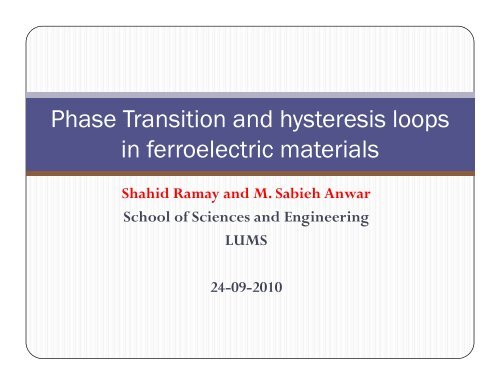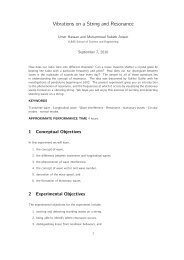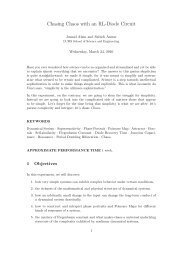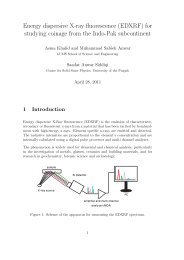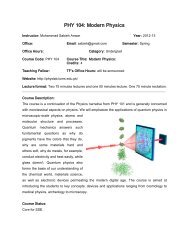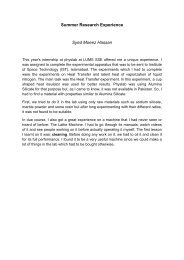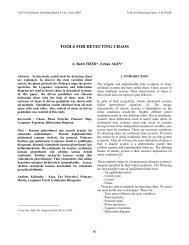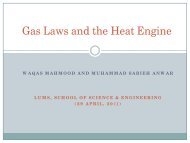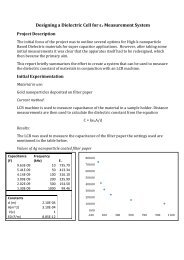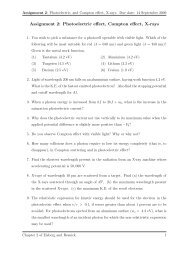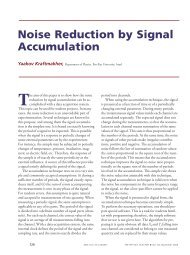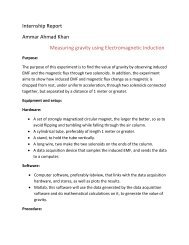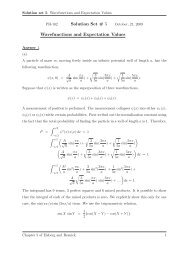Phase Transition and hysteresis loops in ferroelectric materials
Phase Transition and hysteresis loops in ferroelectric materials
Phase Transition and hysteresis loops in ferroelectric materials
Create successful ePaper yourself
Turn your PDF publications into a flip-book with our unique Google optimized e-Paper software.
<strong>Phase</strong> <strong>Transition</strong> <strong>and</strong> <strong>hysteresis</strong> <strong>loops</strong><br />
<strong>in</strong> <strong>ferroelectric</strong> <strong>materials</strong><br />
Shahid Ramay <strong>and</strong> M. Sabieh Anwar<br />
School of Sciences <strong>and</strong> Eng<strong>in</strong>eer<strong>in</strong>g<br />
LUMS<br />
24-09-2010
•Outl<strong>in</strong>es<br />
• Insulators<br />
• Functional <strong>in</strong>sulators<br />
• Ferroelectrics<br />
• <strong>Phase</strong> transition <strong>in</strong> BaTiO 3<br />
• Ferroelectricity <strong>in</strong> BaTiO 3<br />
• Sawyer Tower Circuit for KNO 3<br />
• Observation of <strong>ferroelectric</strong> <strong>hysteresis</strong> <strong>loops</strong> of KNO 3<br />
th<strong>in</strong> films<br />
• Future plan
Insulators<br />
• Whether the material is a conductor or an <strong>in</strong>sulator depends<br />
on how full the b<strong>and</strong>s are, <strong>and</strong> whether or not they overlap.<br />
An <strong>in</strong>sulator is a material hav<strong>in</strong>g conductivity <strong>in</strong> the<br />
range of 10 -10 to 10 -16 Ω -1 m -1
Functional Insulators<br />
• Dielectrics<br />
• Piezo-electricselectrics<br />
• Ferroelectrics<br />
A dielectric material is any material that support charge without<br />
conduct<strong>in</strong>g it to a significant degree or any electrical <strong>in</strong>sulator is also<br />
called a dielectric.<br />
In vacuum<br />
But the magnitude of charge per unit<br />
area on either plate is called ‘electric<br />
displacement’<br />
Here (C/m 2 ) is called electric displacement<br />
<strong>and</strong> also called surface charge density on the<br />
plate <strong>in</strong> vacuum
Dielectrics i (cont<strong>in</strong>ued)<br />
• The surface charge density can be related to capacitance of a<br />
parallel plate capacitor <strong>in</strong> vacuum as follows:<br />
But<br />
Then<br />
Here C 0 = capacitance <strong>in</strong> vacuum<br />
= permitivity of free space<br />
ε<br />
0<br />
A= Area of the plates<br />
l = distance between the plates<br />
q = charge on each plate<br />
V = P.D between the plates
Dielectrics (cont<strong>in</strong>ued)<br />
In the presence of ‘Dielectric material’<br />
A displacement of charge with<strong>in</strong> the material is<br />
created through a progressive orientation of<br />
permanent or <strong>in</strong>duced dipoles.
Polarization<br />
• The <strong>in</strong>teraction between permanent or <strong>in</strong>duced electric<br />
dipoles with an applied electric field is called polarization,<br />
which is the <strong>in</strong>duced dipole moment per unit volume.<br />
• Electronic Polarization<br />
• It occurs due to centre of the<br />
electron cloud around a<br />
nucleus is displaced under an applied electric field. It gives rise to<br />
net dipole moment per unit volume.
Ionic Polarization<br />
• It occurs <strong>in</strong> ionic <strong>materials</strong> because an applied field acts to<br />
displace cations <strong>in</strong> the direction of the applied field while<br />
displac<strong>in</strong>g anions <strong>in</strong> a direction opposite to applied field. It<br />
gives rise to dipole moment per formula unit.
Oi Orietational ti lPolarization<br />
• It is temperature dependent polarization. It occurs <strong>in</strong><br />
<strong>materials</strong> composed of molecules that have permanent<br />
electric dipole moments. The permanent dipoles tend to<br />
become aligned with the applied electric field, but entropy<br />
<strong>and</strong> thermal effects tend to counter this alignment.<br />
e.g Liquid <strong>and</strong> gases where molecules are free to rotate
Space-Charge Polarization<br />
• It results from the accumulation of charge at structural<br />
<strong>in</strong>terfaces <strong>in</strong> heterogeneous <strong>materials</strong>. Such polarization<br />
occurs when one of the phases has a much higher resistivity<br />
than the other, it is found <strong>in</strong> a variety of ceramic <strong>materials</strong>.
Note:<br />
• D is connected with the free charge only. The l<strong>in</strong>es of D beg<strong>in</strong> <strong>and</strong><br />
end on free charges. D is constant throughout the capacitor.<br />
• P is connected with polarization charge only. P is zero except <strong>in</strong>side<br />
the dielectric.<br />
• E is connected with all charges.<br />
• In isotropic media P <strong>and</strong> E are <strong>in</strong> the same direction.<br />
• E is reduced <strong>in</strong>side the dielectric.<br />
• The units of P <strong>and</strong> D are C/m<br />
2
E=0
Piezo-electric i <strong>materials</strong><br />
• Word------Quartz-----written on the face of watch----means<br />
• Time steps are set by the oscillations of a piezoelectric<br />
quartz crystal.<br />
• Piezo-electric i effect<br />
A mechanical stra<strong>in</strong> will produce dielectric<br />
polarization <strong>and</strong>, conversely, an applied electric<br />
field will cause mechanical stra<strong>in</strong>.<br />
• Crystals hav<strong>in</strong>g lack of centre of symmetry<br />
y g y y<br />
exhibit this effect.
Piezo-electric effect <strong>in</strong> symmetric <strong>and</strong> nonti<br />
cubic crystals<br />
symmetric Symmetric<br />
cubic structure<br />
Non-symmetric<br />
cubic structure
Ferroelectricity<br />
it<br />
• Spontaneous alignment of electric dipoles by their mutual<br />
<strong>in</strong>teraction ti <strong>in</strong> the absence of an applied electric field.<br />
• Source of <strong>ferroelectric</strong>ity<br />
• It arises from the fact that the local field <strong>in</strong>creases <strong>in</strong><br />
proportion to the polarization. Thus, <strong>ferroelectric</strong> <strong>materials</strong><br />
must possess permanent dipoles.
Why Ferroelectric Materials<br />
• Ferroelectric <strong>materials</strong> are special case of piezo-electric behavior.<br />
They too have an unsymmetric structure, but have the special<br />
ability to switch asymmetry. So to be <strong>ferroelectric</strong>, a material<br />
must possess a spontaneous dipole moment that can be switched<br />
<strong>in</strong> an electric field.<br />
• Ferroelectric <strong>materials</strong> are non-centrosymmetric i-e central atom<br />
must be <strong>in</strong> a non-equilibrium position.<br />
• Normal <strong>materials</strong> with symmetric charge distribution have<br />
dielectric constant <strong>in</strong> the range of 2-20 but <strong>ferroelectric</strong> <strong>materials</strong><br />
have 20,000, this allows their use to make super-capacitors that<br />
can store 1000 times more energy than conventional capacitors<br />
<strong>and</strong> can be competed with batteries for energy storage.<br />
• Examples<br />
• BaTiO 3 , KNO 3 , PbTiO 3 ,PZT <strong>and</strong> BiFeO 3
Ferroelectricity it <strong>in</strong> BaTiO 3 (Prevoskite)<br />
Above 120 ˚C, BaTiO 3 has cubic structure. In a unit cell<br />
Ba<br />
2+ ---------Centre<br />
Ti 4+ ---------Cube corner<br />
O 2- ----------Centre of cube edges<br />
Ti-ion (75pm)-----surrounded by octahedron of<br />
O 2-<br />
Fractional co-ord<strong>in</strong>ates are<br />
Ti(0,0,0) 0 0)<br />
Ba(1/2,1/2,1/2)<br />
O(1/2,0,0), (0,1/2,0),<br />
(0,0,1/2)<br />
Cubic <strong>Phase</strong> is non-<strong>ferroelectric</strong>
Tetragonal phase of BaTiO 3 (<strong>ferroelectric</strong> phase)<br />
• At 120 ˚C------Cube----distort----<br />
TiO 6 group----distort<br />
• Ti 4+ ion displaces along a Ti-O bond<br />
axis.<br />
• This displacement of Ti 4+ ion causes a<br />
non-overlap of the positive <strong>and</strong><br />
negative charge centers, result<strong>in</strong>g <strong>in</strong> a<br />
permanent electric dipole moment.<br />
Neighbor<strong>in</strong>g doma<strong>in</strong>s have electric polarization that are<br />
either 90 or 180 degree w.r.t each other.
Maple simulation of RC-parallel l circuit<br />
it
Development of Sawyer Tower Circuit<br />
it
Future Plan<br />
• Design<strong>in</strong>g of Sawyer Tower Circuit for all k<strong>in</strong>d of<br />
<strong>ferroelectric</strong> <strong>materials</strong>.<br />
• Deposit<strong>in</strong>g <strong>ferroelectric</strong> th<strong>in</strong> films with sp<strong>in</strong>-coater<br />
• Study<strong>in</strong>g <strong>ferroelectric</strong> <strong>loops</strong> at different frequencies.
Thanks with<br />
Good Energy!


